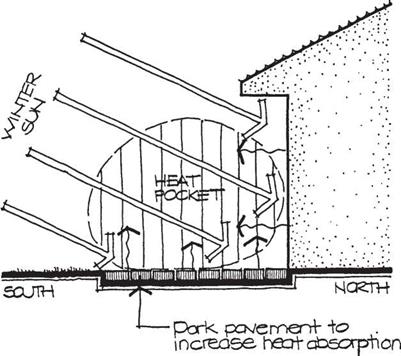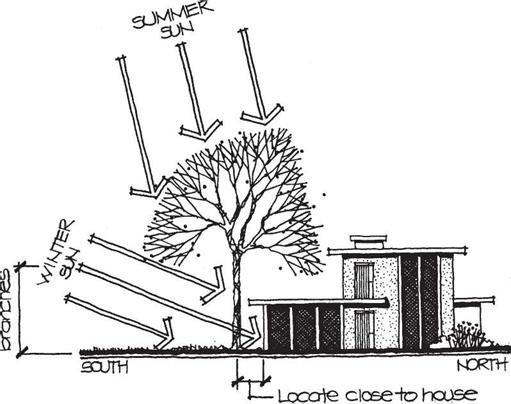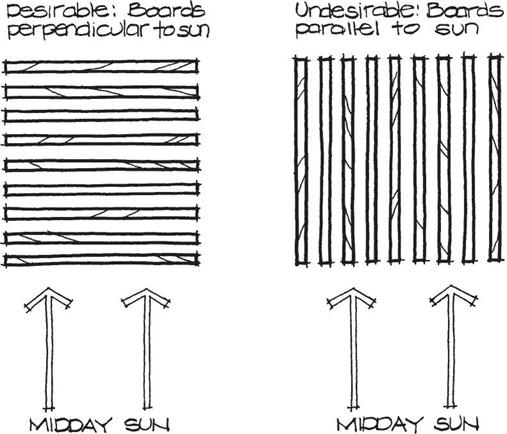Exposure to the sun is desirable for the late autumn through early spring months of the year. This need is greatest in northern regions and less in southern regions of the country. During these months, exposure to sun can increase air temperatures in exterior
|
Figure 3-22 Individual members of an overhead structure should be oriented perpendicular to the direction of the midday sun. |
spaces and make them more enjoyable to use for longer periods of time. This is especially true in the transitional months of October/November and March/April. Likewise, exposure of interior spaces to sun can increase ambient room temperatures and reduce heating costs during the winter season.
One technique for maximizing sun exposure of exterior spaces in the winter season is to locate the spaces properly. As previously suggested, outdoor spaces that are used during the cool season should, where possible, be put on the south side of the house to receive full sun exposure during the day. Outdoor spaces located on the south side of a residence will also benefit from a “heat pocket” effect created by heat reflected away from the exterior house wall and the adjoining ground plane (Figure 3—23). A dark-colored pavement can accentuate this heat buildup by absorbing more sun rays and converting them into heat. Outdoor spaces intended for the cool season should not be placed adjacent to the north side of a residence.
A number of site design concepts need to be considered to maximize sun exposure. One is to use a predominance of deciduous vegetation on the south side of a house. Deciduous trees and other vegetation are able to shade the house during the summer but allow the winter sun to pass through when leaves are absent. Even so, they also need to be carefully located and selected. Deciduous trees should be widely spaced on the southern side of the house so that as much sun exposure as possible is gained. Too many trees in this location will reduce the amount of sun that is able to strike the southern side of the house.
Furthermore, it is best to use trees that are limbed up and to locate them relatively close to the house, except in fire-prone areas (Figure 3—24). In this position,
|

![]()
![]()
 -for maximum winter exposure ф summer shads.
-for maximum winter exposure ф summer shads.
trees will provide effective shade over the house roof in the summer, but will allow the winter sun, with its lower sun angle, to shine below the tree canopy where it can directly strike the walls and windows of the house. Deciduous plants that have an open or loose branching structure are preferred for the south side of the house to minimize the number of individual branches that block the sun. Densely branched deciduous plants and most evergreen vegetation should be minimized, if used at all, on the south side of the house. Evergreen plants will, of course, completely block the sun’s rays and eliminate their potential heating effect.
One other thought for amplifying sun exposure is to maximize the amount of window area on the south side of the house. When the sun’s rays pass through a window, they are converted to heat energy by the surfaces they strike. This heat is retained inside the room, referred to as a “greenhouse effect.” No shrubs should be planted that screen the sun from windows on the south side. When the arrangement of outdoor spaces allows, an area of pavement placed immediately adjacent to sliding glass doors or other similar expanses of windows can increase the heat gain by reflecting some sun into nearby rooms (Figure 3—25).




